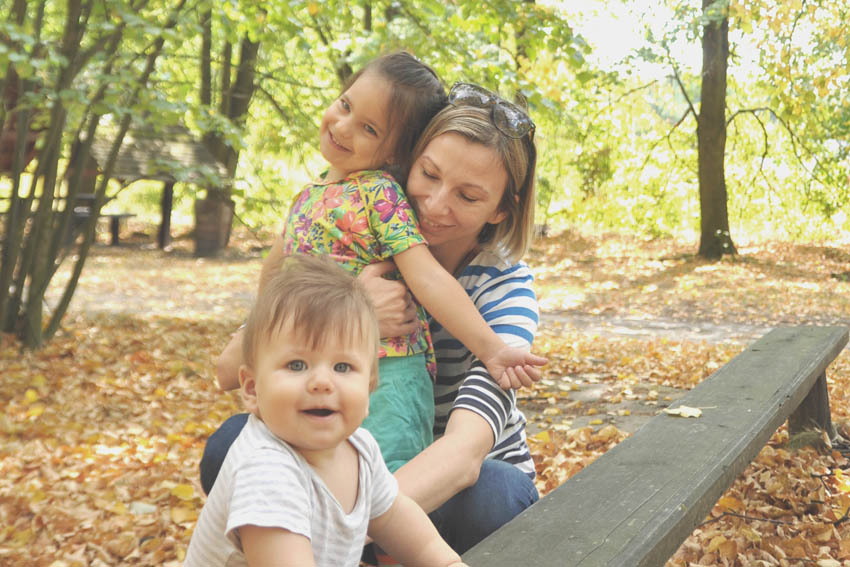As a rule of thumb: As long as you and the baby/child are happy to. Your baby/child will let you know when they’ve had enough and so will your body. With time and as you get experience you will discover that different carries and carriers work better for you and your growing child – this keeps changing and is worth paying attention to, so that the babywearing experience is comfortable for both. Regarding the weight, the wraps and slings are extremely durable and can hold even an adult.
If you and your child are happy to, you can keep on wearing them for several years.
If you would like to know how long can you wear a baby at a time, or how many hours per day, then it all depends on your lifestyle, baby’s temperament and needs. You should always follow your baby’s cues and you will understand when they have had enough. The position the baby takes in a wrap or a sling is not in any way dangerous for their development so you don’t need to worry about this, as in the case of car seats, relax chairs etc. Of course common sense and balance is needed, as the baby should also be able to take other positions, e.g. lying flat, lying on the belly etc.
Based on the knowledge we have about the newborn’s spine and muscular system (see here), the best position for him in a sling is upright, with legs bent to 90 degrees and out of the carrier, and the head supported by the upper edge of the sling. To achieve and withhold such position, a woven wrap or a ring sling is needed, as it gives allows to fully adjusting it over the baby’s body.
All other types of carriers allow achieving only seemingly correct position, however the support they provide is far from perfect.
You can start wearing your baby as soon as they reach 2 kg, as long as you are using the right carrier and the right carry. So, even premature babies can be carried. Beware though that you might not feel up to babywearing for some time after delivery, depending on how your recovery process is going.
Babies are born with a genetically programmed set of expectations and needs, and they are not limited to eating and warmth. The need of being physically close to the adult, in fact – the need to be carried – is natural to human babies and as strong and as important as the other, more commonly recognized needs. Just as it is not possible to spoil the baby by offering them food, it is also not possible to spoil them by offering love and attention.
Research confirms time and time again that being responsive to a child’s needs is important for them to be able to form a secure attachment, which is important in order for your growing child to be able to cope and find their way in this complex world and reach their full potential. Meeting your child’s needs will build trust and self-confidence in him. These are the best foundations for him to move out into and explore the world.
Breastfeeding in a sling is a common practice among babywearing mums, however I see it as an individual choice and can’t teach how to do it. Each mum and baby, if needed, will find their way to do it in a most comfortable way for both of them. It is important to remember about safety though, never let the baby to fall asleep in a cradle position and be aware that in case of chocking it may take a moment to take the baby out of the sling.
Some parents notice that their babies very curious of the world around them, enjoy looking at the surroundings more than facing the parent. For these babies, it would be recommended to try hip carry, where the baby’s perspective is wider, or a back carry, from where they can look at the world easily. Carrying babies facing forward in any carrier is not recommended, as it is physically impossible to achieve the desired spine position (see here). Additionally, the baby has no possibility to switch off and rest their head on the parent, and calmly fall asleep. Carrying babies acing forward can lead to overstimulation – it is a lot to take in for a small baby, away from the safety of our body.
If done correctly, carrying a baby in a carrier will be much better for your back then carrying them in your arms. Carriers allow for saving as much as 15% of energy as opposed to hand carrying. Evenly distributed weight on both shoulders, baby being snuggled close to your body and high up will make babywearing comfortable. As the baby grows bigger it is good to consider the option of back carrying and limiting the use of one shoulder carries. If you experience pain when babywearing contact me and we will try to figure out what carry is best for you.
Introducing touch can be started soon after birth, as the sense of touch is the first sense to develop in womb. Start with skin-to-skin care, which involves placing your baby on your chest to facilitate close contact between you and your baby. You can gradually introduce back and leg strokes and then involve other parts of the baby’s body. By following your baby’s cues, looking for signs of being quiet and alert, you can begin massage during the first few weeks after birth and then gradually develop a nurturing routine that will last a lifetime. You will learn all this in your IAIM Infant Massage class



